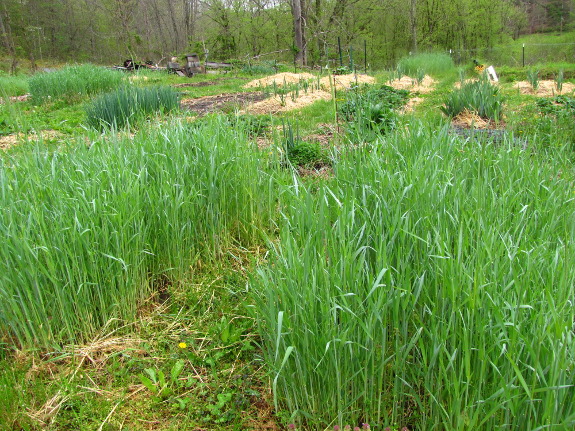
Buckwheat challenge

 The effects of cover crops are surprisingly
long-lasting in the garden. This spring, I've been finding
stunning oilseed
radish skeletons littered throughout the garden beds, along with a
few roots that must have survived the winter by freezing solid then
slowly thawing during our cold spring. Of course, the most
noticeable effect of winter cover crops is soft, dark soil in beds that
barely have any weeds, and I've definitely been enjoying the easy
spring soil prep that radishes made possible.
The effects of cover crops are surprisingly
long-lasting in the garden. This spring, I've been finding
stunning oilseed
radish skeletons littered throughout the garden beds, along with a
few roots that must have survived the winter by freezing solid then
slowly thawing during our cold spring. Of course, the most
noticeable effect of winter cover crops is soft, dark soil in beds that
barely have any weeds, and I've definitely been enjoying the easy
spring soil prep that radishes made possible.

The rye also seems to be working
well, with the tallest plants just starting to bloom. We'll cut
the rye down early next week, once most plants are blooming, and then
I'll plant
directly into that mostly weed-free soil around the beginning of
June. Rye will provide a homegrown mulch for summer vegetables,
and the tall grain outcompeted most weeds over the winter and early
spring.

The cover crop circle
continues with buckwheat soon to go into any open beds that won't be
used for crops until at least June 1. I managed to plan out my
garden rotation for the rest of the year already, which will make it
easy to slip buckwheat into beds that are slated to be used for late
plantings of corn, beans, squash, and cucumbers. A few beds are
even due to be left fallow until fall, which, in practice, means back-to-back
plantings of
buckwheat all summer long.
My goal is to use an
entire 50-pound bag of buckwheat seeds this year, which should add an
astonishing amount of organic matter to the soil. Care to enroll
your garden in my Buckwheat Challenge? You can usually find
buckwheat for about 30 cents per pound at the feed store, so you'll
likely find buckwheat-produced organic matter cheaper than any
storebought soil amendment.
Want more in-depth information? Browse through our books.
Or explore more posts by date or by subject.
About us: Anna Hess and Mark Hamilton spent over a decade living self-sufficiently in the mountains of Virginia before moving north to start over from scratch in the foothills of Ohio. They've experimented with permaculture, no-till gardening, trailersteading, home-based microbusinesses and much more, writing about their adventures in both blogs and books.
Want to be notified when new comments are posted on this page? Click on the RSS button after you add a comment to subscribe to the comment feed, or simply check the box beside "email replies to me" while writing your comment.

Nicki --- Except in the fall when days are getting shorter, buckwheat generally reaches bloom stage in right about a month. If you're desperate, though, you can cut it down sooner --- it seems to die very well. On the other hand, letting it reach bloom gives you maximum biomass.
When I'm in a hurry with buckwheat (which is nearly always), I yank it out and use it as a mulch along the bed edges rather than actually cutting it. In that case, you can plant into the bed immediately after yanking, but of course you won't get the humus for a few weeks until the buckwheat decays into the ground. If you instead cut the buckwheat, you might want to wait a week, or just topdress with extra compost and plant immediately.
It's hard to go wrong with buckwheat. Have fun!
I'll join your challenge. I've been really pleased with the no-work, fast production of biomass the past two years using a buckwheat/cowpeas mix. I'll sprinkle it anywhere I'm looking at a month of bare soil coming up.
Here in Northern CA, it's time to plant out my squash/melons/cukes. I don't have enough mulch to keep the bare soil around the plants covered until they spread out. What do you think about sowing some buckwheat in between the plants to compete with the really annoying weeds? I am wondering if the buckwheat would compete with the cucurbits too much for water/nutrients. I am thinking that as soon as it looks like there might be competition for sunlight, I can just pull the buckwheat and lay it down around my food producers. Anyone have thoughts on this plan?